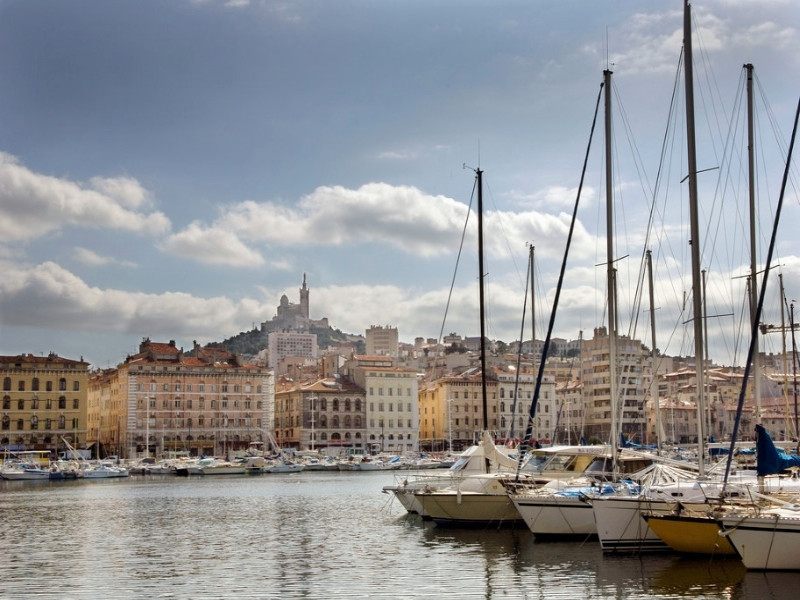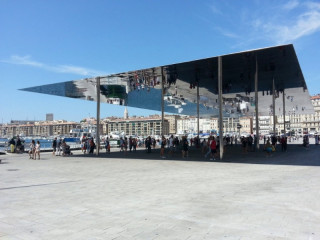Rive Neuve (South shore of the Old Port)
Historic site and monumentPresentation
The former Arcenaulx of Marseille occupied a space between the rue Breteuil, the quai des Belges, the quai de Rive-Neuve and the rue Fort Notre-Dame.
The Thiars place.
The history of the Arcenaulx began under Charles VIII at the end of the 15th century and ended in the middle of the 18th century when the last galley slaves were distributed among the chiourmes of Brest, La Rochelle and Toulon.
About 10,000 galley slaves lived there in deplorable conditions, chained day and night, freezing to death in winter (especially in 1710 when the port froze!), suffocating from the heat in summer... Nevertheless, some of them kept stores on the port or worked in the soap factories of the rue Sainte and the Place aux Huiles, thus ensuring a meager income. The "chiourme" was created by Charles IX in 1564. It was originally made up of Turks, "negroes" and common law prisoners, then in the 17th century Protestants were added. The Arsenal des Galères was a city within a city where galley slaves, non-commissioned officers and officers lived together in an extreme stench, sometimes masked by the great celebrations given by these gentlemen of the officers' corps.
In 1494, Charles VIII left for the Italian wars and had six galleys armed in Marseille, then in 1512 Louis XII had six new terceneaux (shipbuilding and repair sheds) built. Over the centuries their number increased. But it was not until 1660, when Louis XIV came to Marseille, that a Grand Arsenal des Galères was built and a new urban plan was drawn up for Marseille. Less than six years later, Nicolas Arnoul, Colbert's trusted advisor, undertook the modernization of the arsenal, which was to become one of the elements of the city's remodeling. The city grew from 65 to 195 hectares and was equipped with a new wall. The 1666 expansion was the most important urban planning operation carried out in Provence in modern times, and for the first time in its history, the port was at the heart of the city. Indeed, the Greek city was founded on the north side of the harbor and it was only in the 17th century that residential areas were built on the south side of the harbor. The Grand Arsenal now extends as far as rue Paradis and the bottom of the Canebière where the administration buildings are arranged around the Pavillon de l'Horloge. Other existing buildings, such as the convict hospital, are reused and included in the perimeter of the new arsenal.
The fish auction
In 1909, a fish auction was opened and remained in operation until 1975, when the fish market was transferred to the north of the city to the industrial port of Saumaty. The building was then completely redesigned from the inside, but its façade retained its original layout. The Théâtre National de Marseille was inaugurated in 1981 by the Mayor of Marseille, Gaston Defferre. Directed for more than ten years by Marcel Maréchal, "la Criée" has a very good program each season.
Vincent Scotto was born on April 21, 1874 at number 32 of the Rive Neuve quay.
Almost opposite the ferry landing is the Bar de La Marine, which owes its fame to Marcel Pagnol. It remains the main setting for the trilogy "Marius, Fanny, César", whose action takes place on the Old Port in 1930s Marseille.
*** Translated with www.DeepL.com/Translator (free version) ***
The history of the Arcenaulx began under Charles VIII at the end of the 15th century and ended in the middle of the 18th century when the last galley slaves were distributed among the chiourmes of Brest, La Rochelle and Toulon.
About 10,000 galley slaves lived there in deplorable conditions, chained day and night, freezing to death in winter (especially in 1710 when the port froze!), suffocating from the heat in summer... Nevertheless, some of them kept stores on the port or worked in the soap factories of the rue Sainte and the Place aux Huiles, thus ensuring a meager income. The "chiourme" was created by Charles IX in 1564. It was originally made up of Turks, "negroes" and common law prisoners, then in the 17th century Protestants were added. The Arsenal des Galères was a city within a city where galley slaves, non-commissioned officers and officers lived together in an extreme stench, sometimes masked by the great celebrations given by these gentlemen of the officers' corps.
In 1494, Charles VIII left for the Italian wars and had six galleys armed in Marseille, then in 1512 Louis XII had six new terceneaux (shipbuilding and repair sheds) built. Over the centuries their number increased. But it was not until 1660, when Louis XIV came to Marseille, that a Grand Arsenal des Galères was built and a new urban plan was drawn up for Marseille. Less than six years later, Nicolas Arnoul, Colbert's trusted advisor, undertook the modernization of the arsenal, which was to become one of the elements of the city's remodeling. The city grew from 65 to 195 hectares and was equipped with a new wall. The 1666 expansion was the most important urban planning operation carried out in Provence in modern times, and for the first time in its history, the port was at the heart of the city. Indeed, the Greek city was founded on the north side of the harbor and it was only in the 17th century that residential areas were built on the south side of the harbor. The Grand Arsenal now extends as far as rue Paradis and the bottom of the Canebière where the administration buildings are arranged around the Pavillon de l'Horloge. Other existing buildings, such as the convict hospital, are reused and included in the perimeter of the new arsenal.
The fish auction
In 1909, a fish auction was opened and remained in operation until 1975, when the fish market was transferred to the north of the city to the industrial port of Saumaty. The building was then completely redesigned from the inside, but its façade retained its original layout. The Théâtre National de Marseille was inaugurated in 1981 by the Mayor of Marseille, Gaston Defferre. Directed for more than ten years by Marcel Maréchal, "la Criée" has a very good program each season.
Vincent Scotto was born on April 21, 1874 at number 32 of the Rive Neuve quay.
Almost opposite the ferry landing is the Bar de La Marine, which owes its fame to Marcel Pagnol. It remains the main setting for the trilogy "Marius, Fanny, César", whose action takes place on the Old Port in 1930s Marseille.
*** Translated with www.DeepL.com/Translator (free version) ***
Opening period (s)From 01/01 to 31/12, daily.
General information
- Park :
- Calanques National Park
Services, Tours, Activities and entertainment
- Historical patrimony :
- Historic patrimony
- Historic district
Contact
Rive Neuve (South shore of the Old Port)
Quai De Rive Neuve
13001
Marseille
Phone : +33 4 91 00 00 00

Destination
Rive Neuve (rive Sud du Vieux Port)
Quai De Rive Neuve
13001
Marseille
GPS coordinates
Latitude : 43.293744
Longitude : 5.372749
We also suggest...
Historic site and monument
New landmark on the Old Port designed by the British Norman Foster, the 22m by 48m Ombrière has a triple function.




